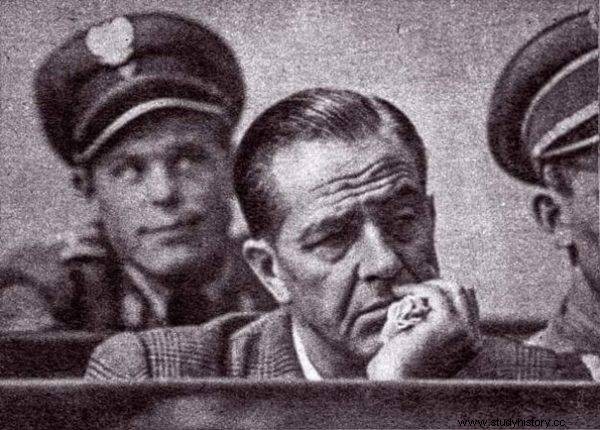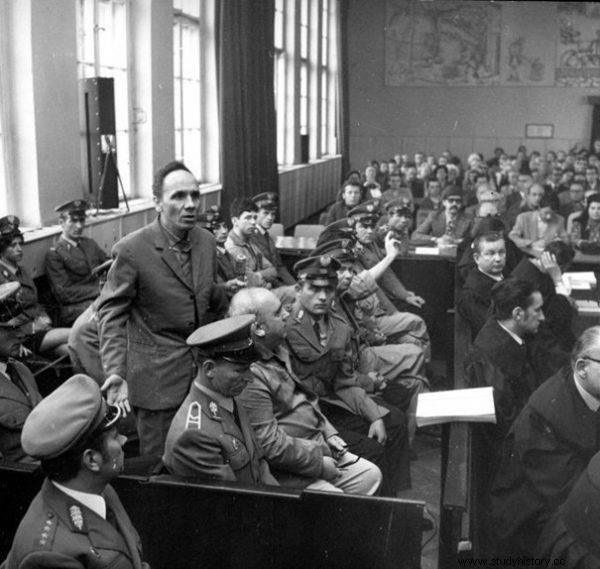Corpses abandoned in the wasteland or in city side streets. Mutilated, exposed, used. Such views had to be faced by the PRL militiamen. How to catch a serial killer if officially the authorities deny that there is such a prowl? Get to know the stories of four Polish degenerates and the pursuit of monsters in human skin ...
They walked alone down the dark street. It was late evening. Or is it night already? They were in a hurry to reach the place where someone close to them was probably waiting for them as soon as possible. However, they never returned home, as he stood in their way - an inconspicuous, kind, even handsome man. He had only one drawback - he was a serial killer.
"Elegant killer":the first
Władysław Mazurkiewicz was a rich and respected man. In the difficult post-war times, he drove a luxury car and smelled of expensive Western perfumes. Funny, attractive, well-mannered and always elegant, he aroused admiration among men and admiration among women. Nobody even for a moment guessed that he was a cruel serial killer. The first in post-war Poland to commit crimes solely for profit.
The second, much more terrifying face, the man discovered in himself during the war, in 1940. He killed his victims with potassium cyanide. He served the poison in tea or ham sandwiches. After the murder, he took money and jewelry, and drowned the bodies of the unfortunates in the Vistula. He made an exception only for his two neighbors, whose bodies he bricked up in the floor of his own garage.
Soon he swapped the poison for a gun. He shot his victims in the head. He thought it was faster. In 1955, however, he made a mistake that led him to the gallows. While traveling by car, his fellow passenger fell asleep. Mazurkiewicz decided to use it. He stopped and shot the man.

Władysław Mazurkiewicz had the appearance of a film lover. Who could have suspected that he was really a bloody murderer? (press photo from 1956, public domain).
Unaware of anything, the businessman fled, startled by a sudden boom. He wasn't aware there was a bullet in his skull. It was discovered only by a doctor who saw the man with a headache. The suspicions immediately fell on Mazurkiewicz.
The investigation revealed what the respected gentleman who stood on trial in the summer of 1956 really did. First, Mazurkiewicz did not plead guilty, but after presenting irrefutable evidence, he changed his attitude. From that moment on, he spoke proudly of his murders. Confessed to killing 30 people, mostly women.
The public was very interested in his trial. The press quickly nicknamed him "The Elegant Murderer" and "The Gentleman's Murderer." However, the policemen preferred to call him "The Cracow Phantom". He has only been proven six homicides.
This, however, was enough to sentence him to death. In court, Mazurkiewicz behaved dignified during the trial. He was proud of his actions, smiling, polite and elegant. The same one also went to the gallows at the end of January 1957.
The story of the first Polish serial killer has an almost cinematic ending. When asked for the last word, "Elegant killer" smiled and bowed to everyone, then said, Goodbye gentlemen! We'll all meet there soon! ”
"Vampire of the Basin":monster or victim?
When in the 1960s, a series of brutal murders of women took place in Upper Silesia and Zagłębie, the inhabitants of these areas felt a pang of fear. Somewhere in the dark nooks and crannies a sexual geek was prowling. The manner of attack was always similar. The perpetrator attacked women in an open area, most often close to their place of residence.
He followed them, then crept from behind and hit the head with a blunt instrument. He dragged the dead victims to a secluded place where, after undressing them, he performed various sexual activities. However, there was never any vaginal rape.
The bodies of women with parted thighs have been discovered. Their underwear was cut and their genitals bared. When it turned out that all the attacks were carried out by the same serial killer, the perpetrator quickly received an operational nickname from the militia - "Vampire from the Basin".

The search for the "Vampire from Zagłębie" became a political matter when the niece of the first secretary of the Central Committee of the Polish United Workers' Party, Edward Gierek, fell victim to the psychopath. The killer just had to find himself
The services did not officially inform the public about the marauding psychopath. However, the "street" knew its own. People whispered and repeated overheard rumors. Meanwhile, more women were dying. During the first two years of its activity, "Vampire from Zagłębie" attacked 16 women.
The murder's seventeenth victim made a breakthrough in the investigation. On October 11, 1966 the body of 18-year-old Jolanta Gierek, niece of Edward Gierek, was found who was at that time the first secretary of the KW PZPR. The Polish authorities decided to hunt down the "Vampire from Zagłębie" at any cost. Suddenly, the matter became political - it was believed that the perpetrator "raised his hand" to the people's government. By March 1970, the degenerate attacked 21 times, committing 14 murders.
A special task force called "Anna" (named after the first victim) selected nearly half a thousand suspects. Among them was Zdzisław Marchwicki. He was reported by his wife, who called the militia during another domestic dispute, asking the officers to "take a Vampire".
Marchwicki denied everything. However, the brutal interrogations did their job. During the trial, he confessed to the murders committed. When the judge asked him if he was the murderer, he replied hesitantly:"Well, from what I heard, what I found out, I guess so."
Although the trial was only circumstantial and no hard evidence was presented to Marchwicki, it was concluded that he was the famous "Vampire from the Basin". He was sentenced to death by hanging on April 26, 1977, in a police garage in Katowice. But was Zdzisław, an alcoholic poured in by his wife, really a "Vampire from Zagłębie"?
"Vampire from Bytom":to be the best
During the trial of the "Vampire from Zagłębie", 800 people were present in the courtroom. The seats had to be ticketed, and one of the viewers was Joachim Knychała. A young boy from Silesia, so fascinated by Marchwicki's crimes that he decided to become his successor.
Born in 1952, Knychała hated women. Raised by his mother and grandmother, he experienced many humiliations on their part. The sense of injustice that has always accompanied him, made him take revenge. The cup of bitterness was overwhelmed by the unjust accusation of rape of a friend.
He attacked for the first time in Bytom. It was 1974. His modus operandi it was like the one that was characteristic of The Vampire of Basin. He prowled at night. He followed the victim, then hit him, always from behind. The attacks took place close to the home of the injured women.
The first two women attacked survived. The third was not so lucky, and each subsequent crime triggered even greater contempt for the fair sex in the serial killer. He considered himself a "hunter" and looked for his victims on the tram no. 6. He was nicknamed "The Vampire of Bytom" (well - the police did not sin with creativity), although due to the injuries suffered by the murdered women, Knychale was more often referred to as "Frankenstein ”.

Joachim Knychała
The age and appearance of the women he attacked did not matter to him. He left the corpses in secluded places. They were always dismantled, and post-mortems showed that the rapes were committed after the victims had died. In June 1979, attacked two little girls. Massacred naked bodies were found in a ditch. To the surprise of the officers, one of the children miraculously survived. However, she could not name her tormentor.
The always flawless Knychała "exposed himself" to his hunters. After the murder of his 17-year-old sister-in-law Bogusia, which he had done with a pickaxe, he informed the police about the accident. However, the doctors concluded that it was most certainly a planned attack.
The "Vampire from Bytom" was arrested during her funeral. Trapped Knychała confessed to the murders and told about them in detail. He was proud of his accomplishments. He was hanged on October 28, 1985. It was the penultimate execution in the history of Poland.
"Vampire from Bytów":the dead do not refuse
Leszek Pękalski was convicted of killing one person. Nevertheless, the media hailed him as a serial killer. Why? Well, he himself confessed to over 70 (according to some sources, 90) murders, which he described in many details during local inspections. However, the prosecution did not find sufficient evidence to incriminate him.
Handicapped from birth, by his fellow residents of Borzytuchom (a Kashubian village near Bytów) he was considered a harmless madman . How many women he really murdered, only he knows. He claimed that he killed because that was the only way he could satisfy his sex drive. Previously, he offered his victims sex, but was always refused. As he testified, "When they were dead, they didn't refuse anymore."
After the attack, he undressed women to play with their genitals. He rarely raped, usually masturbation was enough. It pleased him that the women were not laughing at him. So he could do what he imagined in his sick imagination in peace. When he was arrested in 1992, he began to plead guilty to all unsolved murders in Poland in the last dozen or so years. However, he then withdrew his testimony.
After an inept investigation, he was charged with only 17 murders. One thing was proven and sentenced to 25 years in prison. Behind bars, Pękalski became a media star. He told journalists about his (alleged?) Crimes. Due to his behavior, he was given the nickname "The Vampire of Bytów". He was also sometimes referred to as "Death Wholesaler" - but he himself did not like that term.
***
In a time when the world was divided into two hostile camps and two powers fought for domination - imperialist "spoiled America" had its "Zodiac", "Ted Bundy", "Son of Sam" and "Stranglers from the hills". There were no such criminals in socialist Poland. However, contrary to what we said - we also had dangerous serial killers who were in no way inferior to their famous American counterparts. They were just as cruel and ruthless. And it was just as difficult to catch them…
